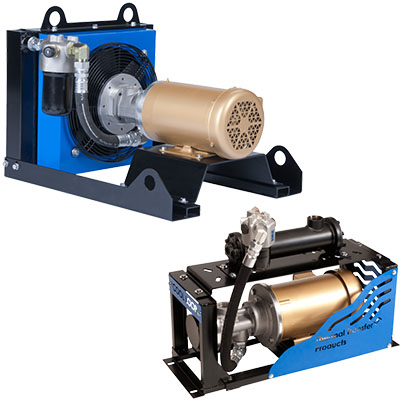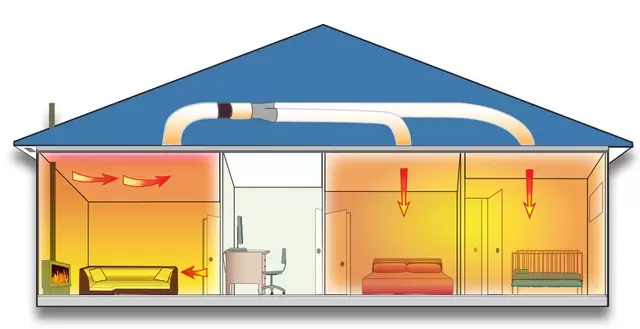Exploring Advanced CFD Modeling in DVS Heat Transfer Systems
Wiki Article
A Comprehensive Overview to Picking the Right Heat Transfer Solutions for Your Needs
Picking the appropriate Heat transfer system is crucial for functional performance. Numerous systems accommodate different requirements, influenced by variables such as temperature range and liquid type. Understanding the principles behind Heat transfer, such as radiation, conduction, and convection, is vital. In addition, evaluating power resources and upkeep techniques can influence long-lasting performance. A closer assessment of these considerations exposes how to customize a system to details requirements. What should one prioritize in this complicated decision-making procedure?Comprehending Heat Transfer: Trick Concepts and Principles
Although Heat transfer might appear like a straightforward concept, it incorporates a range of principles that are basic for reliable system design. Understanding these principles is essential for designers and engineers who aim to maximize thermal efficiency in numerous applications. Transmission, for example, involves the transfer of Heat through solid materials, while convection refers to the movement of Heat within liquids. Radiation, one more essential concept, describes just how Heat can be moved with electromagnetic waves. Each of these systems plays an essential duty in figuring out exactly how power relocates within a system. By extensively understanding these concepts, experts can make enlightened decisions, making sure that Heat transfer systems run effectively and meet the specific demands of their applications
Sorts Of Heat Transfer Equipments: A Review
Recognizing the principles of Heat transfer lays the groundwork for exploring the numerous kinds of Heat transfer systems readily available. Heat transfer systems can be categorized mainly into 3 types: convection, radiation, and conduction. Conduction entails Heat transfer via strong materials, relying on straight get in touch with between bits. Convection, on the other hand, takes place in liquids (fluids and gases) where the movement of the fluid itself promotes Heat transfer. Radiation involves the transfer of Heat through electromagnetic waves and does not require a tool, permitting it to happen in a vacuum. Each sort of system has unique features and applications, making it important for individuals and organizations to meticulously examine their details needs when selecting the most ideal Heat transfer solution.Applications of Heat Transfer Equipments in Different Industries
Heat transfer systems play an essential function throughout numerous markets, influencing effectiveness and item top quality. In industrial production procedures, they facilitate specific temperature control, while in food and drink handling, they guarantee security and preservation. Additionally, cooling and heating and climate control systems depend heavily on reliable Heat transfer to maintain comfy environments.Industrial Production Processes

Numerous industrial manufacturing processes depend greatly on reliable Heat transfer systems to make the most of performance and boost product top quality. In industries such as metalworking, Heat exchangers play a necessary duty in keeping suitable temperature levels during welding, casting, and building. These systems ensure consistent Heat circulation, which is essential for accomplishing wanted product homes. In the chemical manufacturing sector, Heat transfer systems promote exact temperature level control throughout reactions, impacting return and safety. In textile production, efficient Heat management is vital for coloring and finishing procedures, influencing color uniformity and material high quality. By selecting ideal Heat transfer modern technologies, makers can improve power performance and lower operational costs, inevitably resulting in a more affordable and lasting manufacturing setting.
Food and Beverage Processing
Effective Heat transfer systems are equally vital in the food and drink handling sector, where keeping optimal temperature levels is crucial for food security and top quality. These systems play a crucial duty in processes such as pasteurization, sterilization, and food preparation, ensuring that items are secure for usage and preserve their nutritional worth. Heat exchangers, for instance, effectively move Heat between liquids, maximizing energy usage while lessening temperature changes. Additionally, refrigeration systems are fundamental for preserving disposable items and expanding life span. The selection of Heat transfer innovation straight influences functional efficiency and item integrity, making it critical for food and beverage manufacturers to pick the suitable systems tailored to their particular processing requirements. This cautious choice inevitably contributes to customer contentment and food security.
Heating And Cooling and Climate Control
While several markets count on Heat transfer systems for effectiveness, HVAC (Home Heating, Air Flow, and Air Conditioning) plays a crucial duty in preserving indoor climate control across different setups. These systems utilize Heat transfer concepts to regulate temperature, moisture, and air high quality, making certain comfort and security in household, commercial, and commercial settings. Correctly created cooling and heating systems improve energy performance, decrease functional expenses, and reduce ecological impact. In commercial structures, for instance, effective climate control adds to worker performance and client contentment. In industrial applications, heating and cooling systems assist keep ideal conditions for equipment procedure and item conservation. Choosing the ideal Heat transfer system is vital for meeting particular climate control needs and attaining total system efficiency.Reviewing Power Resources for Heat Transfer Systems
In examining energy sources for Heat transfer systems, a contrast of renewable energy options and nonrenewable fuel source factors to consider is important. Renewable sources, such as solar and wind, offer lasting options that can reduce environmental effect. On the other hand, nonrenewable fuel sources remain widespread due to their well-known facilities and energy thickness, motivating a careful evaluation of both options.Renewable Power Options

Nonrenewable Fuel Source Considerations
Assessing nonrenewable fuel source considerations is vital for the effectiveness and sustainability of Heat transfer systems. Fossil gas, such as all-natural gas, oil, and coal, are standard energy resources that offer considerable Heat outcome, making them popular options for commercial and domestic applications. Nevertheless, their environmental effect, consisting of greenhouse gas discharges and source deficiency, raises issues. When picking a heat transfer system, it is vital to examine the availability, expense, and regulative factors related to these fuels. In addition, the efficiency of nonrenewable fuel source systems should be taken into consideration, as higher efficiency can mitigate some ecological disadvantages. Inevitably, a well balanced approach weighing performance and sustainability can assist decision-makers towards one of the most ideal Heat transfer option for their particular requirements.Aspects to Consider When Picking a Heat Transfer System
Choosing a proper Heat transfer system calls for careful consideration of different aspects that can considerably impact effectiveness and efficiency. One crucial factor is the operating temperature variety, which dictates the materials and design appropriate for the application. Furthermore, the kind of liquid used in the system-- whether gas or liquid-- affects Heat transfer efficiency and compatibility. The system's dimension and capability must straighten with the certain requirements of the procedure to prevent inadequacies. Energy source schedule is likewise crucial, affecting operating expenses and sustainability. The installation setting, including area constraints and access for upkeep, plays a considerable role in system option. Regulatory compliance and safety and security standards have to be thought about to assure the system satisfies all legal demands.Maintenance and Effectiveness Optimization for Heat Transfer Systems
Preserving Heat transfer systems is crucial for making certain maximum effectiveness and long life. Regular upkeep activities, such as cleansing Heat exchangers and evaluating insulation, assistance avoid efficiency losses as a result of fouling and thermal linking. Furthermore, keeping track of system parameters, consisting of pressure and temperature, enables early discovery of abnormalities, look at these guys reducing downtime and expensive repair services. Executing a precautionary maintenance schedule can optimize performance and prolong the life expectancy of elements. In addition, upgrading to innovative control systems can enhance operational effectiveness by adapting to varying problems and lots. By prioritizing maintenance and performance optimization, operators can achieve decreased power intake, reduced functional prices, and improved overall system reliability, inevitably resulting in far better source application and an extra sustainable operation.Future Trends in Heat Transfer Technologies
As sectors increasingly prioritize sustainability and energy efficiency, future patterns in Heat transfer technologies are set to undergo substantial improvements. Technologies such as sophisticated products, consisting of carbon nanotubes and nanofluids, promise improved thermal conductivity and performance. In addition, the integration of renewable resource resources right into Heat transfer systems is getting energy, advertising eco-friendly services. Smart innovations, consisting of IoT sensors, are anticipated to revolutionize monitoring and control, making it possible for real-time information analysis for maximized performance. Moreover, the growth of modular and compact systems will promote much easier installation and upkeep, accommodating varied applications. These developments show a shift in the direction of more sustainable, reliable, and versatile Heat transfer remedies, lining up with global power goals and environmental criteria.
Regularly Asked Concerns
What Are the Ecological Impacts of Heat Transfer Solutions?
The ecological impacts of Heat transfer systems can include greenhouse gas exhausts, power usage, and possible thermal air pollution. Furthermore, incorrect disposal of inadequacies and materials can add to resource deficiency and ecosystem interruption.Just how Do I Compute the Cost-Effectiveness of a Warm Transfer System?
To determine the cost-effectiveness of a warm transfer system, one should assess initial expenses, operational expenditures, maintenance needs, and power efficiency, contrasting these factors versus the anticipated life-span and efficiency of the system.Can Heat Transfer Equipment Be Used in Residential Settings?
Heat transfer systems can undoubtedly be made use of in property setups. They give efficient heating and cooling services, making homes a lot more comfy while possibly reducing energy expenses. Their versatility permits various applications in domestic atmospheres.What Security Rules Put On Heat Transfer Solutions?
Safety and security guidelines for Heat transfer systems typically include guidelines on upkeep, operation, and setup. Compliance with regional building ordinance, producer specifications, DVS Heat Transfer Systems and industry standards is vital to ensure reliable and secure system performance in various applications.How Do Various Materials Affect Heat Transfer Efficiency?

Transmission, for circumstances, includes the transfer of Heat through strong products, while convection refers to the motion of Heat within liquids. Understanding the principles of Heat transfer lays the foundation for exploring the various kinds of Heat transfer systems readily available. Heat exchangers, for instance, effectively move Heat in between liquids, optimizing power usage while decreasing temperature level variations. In click now evaluating energy resources for Heat transfer systems, a comparison of sustainable power options and fossil fuel factors to consider is important. Metals, such as copper and light weight aluminum, conduct Heat successfully, whereas insulators like rubber and glass slow down Heat circulation.
Report this wiki page